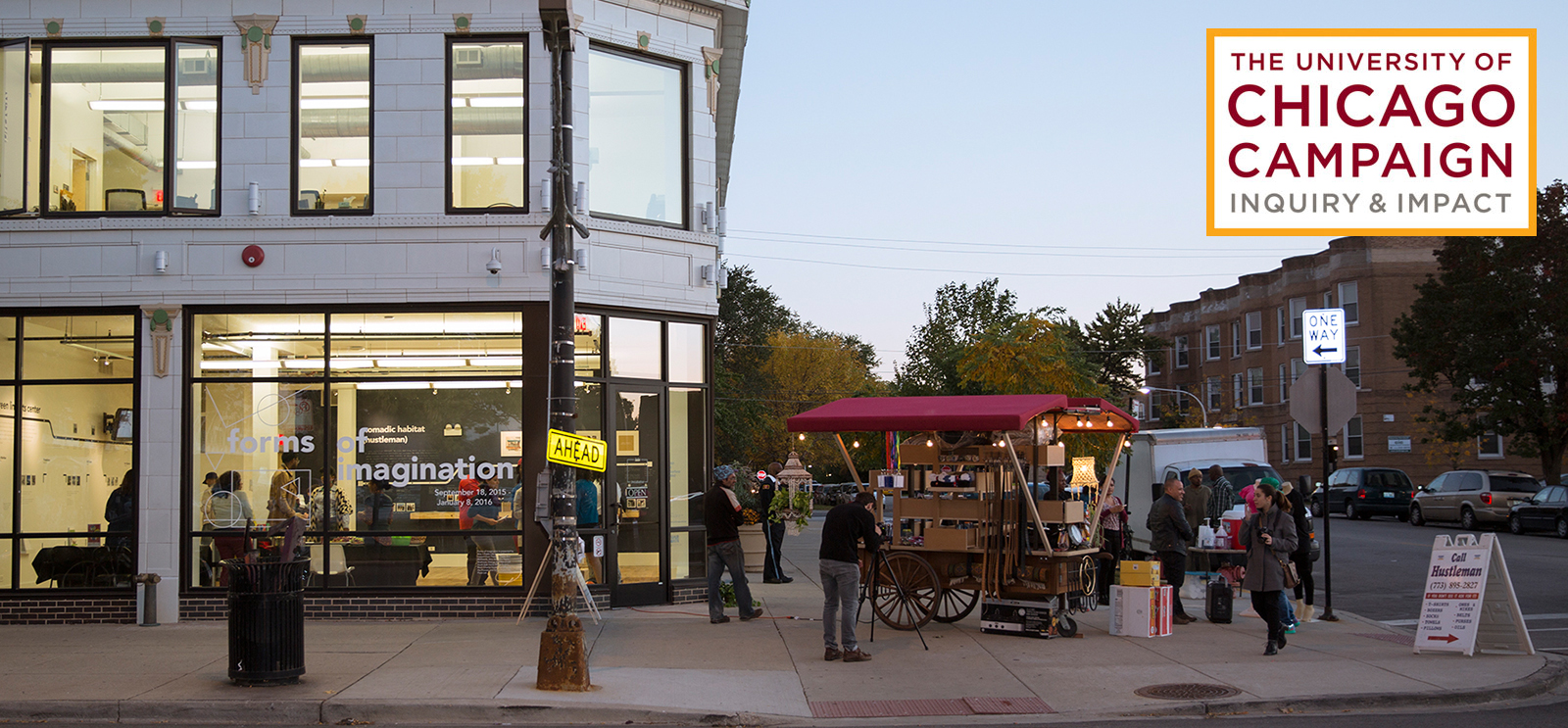
The Arts Incubator offers studio space for local artists and public programs for the broader South Side community. (Photo courtesy Arts + Public Life)
At the Arts Incubator, creative minds build on the cultural wealth of Chicago’s South Side
Garland “Hustleman” Gantt sells snow cones, linens, and other wares out of his white, windowless van. He’s been a fixture of Chicago’s South Side for over 10 years, following opportunity in his mobile mini-mart. Most of the time these days, he’s parked next to the Garfield Green Line stop in Washington Park.
“I started with like, 40 bags of fruit ... selling them in the area,” Gantt told the Chicago Transit Authority in a 2013 interview. He then “expanded to socks, face towels, dish towels, oils, pickles, T-shirts, DVD players, to watches, to sheet sets, to comforters. Stuff like that.”
Gantt’s enterprising background made him an ideal partner in a project by Carlos Rolón/Dzine, a Pilsen-based artist known for his intricate, ornate paintings and sculptures. Working with Gantt last fall, Rolón refurbished a dilapidated wooden vendor cart that had weathered two Chicago winters and turned it into a boutique bazaar on wheels.
With twin red awnings accented with miniature light bulbs and delicate fringe, the cart formed a welcoming space around a central column of drawers and shelves. Built-in speakers played Gantt’s usual selections: music from local radio stations, including R&B, soul, top 40, and Motown. A colorful rug, hanging spider plant, and decorative dollar sign added the finishing touches.
The cart, or Nomadic Habitat (Hustleman), was one of three installations featured in Forms of Imagination, an exhibition that appeared last fall at the Arts Incubator, part of the University of Chicago’s Arts + Public Life initiative. Cocurated by research analyst Paola Aguirre, an urban designer and architect, and arts program manager Tempestt Hazel, a curator and writer, the show explored how the transformation of spaces, from a vendor cart to a city block, can also transform the communities around them.
Gantt relinquished his van in favor of the motorless cart one evening last October, serving dozens of patrons outside the incubator at East Garfield Boulevard and South Prairie Avenue. Rolón explained on Instagram that the cart, which features storage for folding tables and chairs, provided “an oasis for visitors to have random interaction and discussion.” So they did—and in a way, that was the whole point. “Garland brought people out at 8 p.m. on a Wednesday, when usually no one is out around here,” says Aguirre.
Arts + Public Life is headed by Theaster Gates, the potter-turned-urban planner known for his work converting run-down structures into lively cultural attractions. Launched in 2011, Arts + Public Life advances the arts as a way to build connections between the University, local artists, and the city.
“While Washington Park has an amazing legacy of cultural life, it is not immediately evident on the main street,” says Gates. “The Arts Incubator seeks to make some of the cultural life in the neighborhood more evident.”
Washington Park, home to the 372-acre park that bears its name and the DuSable Museum of African American History, was a bustling community until the mid-20th century. Its population declined by 75 percent between 1950 and 2000, leaving its majestic tree-lined boulevards flanked by rows of shuttered gray stones.
Like Nomadic Habitat, the Arts Incubator was a fixer-upper. Inspired by the artistic process of molding raw materials into beautiful objects, Gates saw potential in the two-story terra cotta building, nearly a century old. Thought to be a former Walgreen’s, it had sat abandoned for 20 years when the University purchased it in 2008.
Gates reenvisioned the space as a cultural resource for South Side artists and the local community. After $1.85 million in renovations and a $400,000 grant from ArtPlace (a partnership of 27 foundations, government agencies, and corporations), the Arts Incubator opened in 2013 with 10,000 square feet of studio space for artists in residence, a woodshop for design apprenticeship programming, and room for exhibitions and events.
Over the past three years, the Arts Incubator has drawn more than 25,000 people to 760-plus public events and programs, including live performances, yoga classes, and South Side Home Movies, a screening of old amateur films from the archives of UChicago film professor Jacqueline Stewart, AM’93, PhD’99, who led a discussion following the event. This month the Arts Incubator’s latest exhibition, Shared Language: A Community Classroom, opened. It offers free classes on communication and teaching alongside an exhibition of the work of nine teaching artists (the show runs through March 11).
One of few South Side buildings featured in the 2015 Chicago Architecture Biennial, the Arts Incubator was the first step in Arts + Public Life’s ongoing effort to reestablish Garfield Boulevard as a major cultural corridor in the city of Chicago. The Currency Exchange Café opened next door in 2014, creating a space for local residents to convene, eat, study, work—and peruse purchases from Bing Art Books next door (named for the bingo sign in its window that’s missing a letter).
The sign, like Nomadic Habitat and the Arts Incubator itself, are examples of how to “start with what you got,” as Gates puts it—a philosophy that underlies all of Arts + Public Life’s work to create beautiful, functional environments that draw out the rich culture on Chicago’s South Side.
